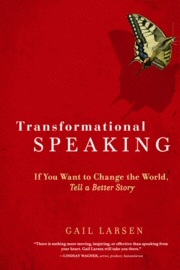Using Your Breath to Gain Focus & Calm Before Speaking
“Fear is merely excitement without the breath.” So stated the legendary psychiatrist Fritz Perls.
So when Sankara Saranam, founder of the Pranayama Institute, attended Real Speaking, I asked him to develop some breathing exercises for speakers. I tried his suggestions below and found them remarkable tools for becoming more present and focused.
Here are three simple yet highly effective methods to gain focus and utilize nervousness to one’s benefit before public speaking. These methods can also be used before meeting someone, to regain composure in a tense moment, or simply as a meditative exercise in the morning and evening by closing the eyes and directing the attention upward toward the brain, especially with every inhalation.
1) Tension-Relaxation— This technique frees your from restlessness. You can invigorate and relax the body through tension-relaxation. Simply perform a multiple inhalation through the nostrils with the mouth closed while simultaneously tensing the entire body. Multiple inhalations are done by breaking the inhalation into many smaller quick inhalations, completing with a long and full inhalation. While tensing, remember to curl the toes, tense the calf muscles, tighten the thighs, clench the fists and buttocks, tighten the abdomen, chest, and biceps, tense the neck, and scrunch the face. After the inhalation, hold the breath for three seconds and maintain the tension in the entire body. Then open the mouth and perform a double exhalation while quickly relaxing the body. To energize and heal a body part, relaxation is normally done very slowly, but to gain the relaxation of all the big and small muscles, relaxation is done very quickly. You can perform this exercise six to twelve times in a row before going to the next.
2) Square Breathing— This technique harnesses nervous energy for your positive use. Next, slowly inhale through the nostrils, filling the lower then upper lungs by expanding the abdomen and chest, to a count of six to twelve seconds, depending on your lung capacity. Hold the breath for the same duration, and then exhale through the mouth for the same duration. Perform this method a dozen times. This technique naturally levels the emotions, calms the mind, and introverts the awareness.
3) Multiple Exhalations— This exercise is for calmness and concentration. After the above exercise, calm and focus are easily had by chopping up the exhalation and stalling the inhalation, as doing so slows the heart rate. While waiting for the call to speak, exhale through the mouth with breaks, making the sound “huh, huh, huh,” then end with a long “huuuuuh” exhalation until all the air is out. These breaks are performed in quick succession, just as we break the exhalation during laughter. It is nature’s way of removing more carbon from the body, which is why laughter is so therapeutic. Since you may not want to break into ruckus laughter backstage while you are being introduced to the audience, use multiple exhalation to reap all the benefit. And there’s an added bonus if, after the last long exhalation, you keep the breath out for three to six seconds: the heart slows, naturally introverts the awareness, and bestows calmness and intensity of concentration. Practice a dozen multiple exhalations, each with a few moments of breathlessness before inhaling, and you will feel extremely centered.
So there you have it. If you’re soft spoken and have to rev up before you speak, use these methods to become calm and centered. Then breathe in, open your eyes wide, and envision yourself making a grand entrance! Remember, what feels grand to you is likely quite understated to your audience, who rarely notice that you’re nervous either! -Gail Larsen
Sankara Saranam holds a BA in Religion from Columbia University and an MA in Sanskrit and Classic Eastern Texts from St. John’s College. A former monk and present-day teacher, lecturer, world traveler, poet and composer, he is author of the just-released God Without Religion: Questioning Centuries of Accepted Truths. Order on-line at www.pranayama.org.
? March 2005





